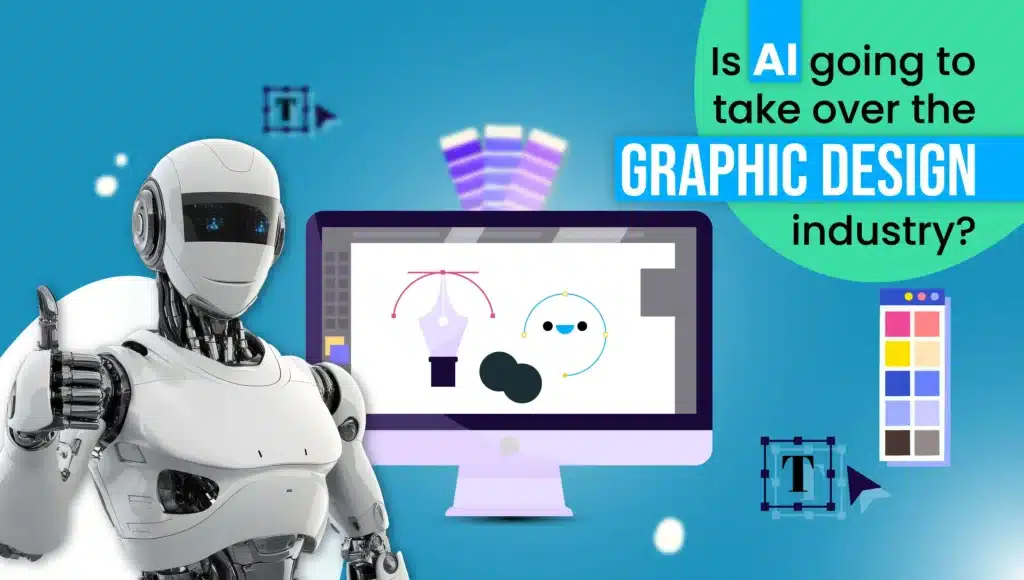The graphic design landscape is evolving rapidly, propelled by the integration of artificial intelligence (AI). As AI becomes increasingly sophisticated, creative communities are asking critical questions: Is AI going to take over the graphic design industry? This concern ties into broader debates about job security, creative autonomy, and how traditional roles are being redefined.
In this article, we’ll explore the rise of AI in design—its impact on professionals, the new opportunities it presents, and how designers can adapt and thrive in this dynamic ecosystem. Rather than focusing on fear, we’ll examine whether AI is a threat to jobs or a transformative force in the creative process.
Will AI Replace Graphic Designers?
Although the fear that AI will replace graphic designers is widespread, it’s often overstated. True, AI tools can generate logos, layouts, and even complete illustrations in seconds. However, they still lack depth in areas like human creativity, emotional intelligence, cultural awareness, and strategic thinking.
Graphic design is not merely about visual appeal—it involves storytelling, problem-solving, user empathy, and brand strategy. These elements demand human insight. As a result, AI is more likely to serve as a creative partner rather than a full replacement, enhancing designers’ workflows instead of rendering them obsolete.
The Future of Graphic Design: Embracing Hybrid Creativity
Human-Machine Collaboration
The future belongs to hybrid creativity—a model where human intuition meets machine intelligence. Instead of starting from scratch, designers are increasingly curating and refining AI-generated content. This enables faster prototyping, more personalized user experiences, and increased efficiency.
For example, AI can instantly generate a wide range of design variations, allowing designers to focus on refining the concept and ensuring it aligns with a brand’s identity and values.
Emerging Roles and Skillsets
As AI takes over repetitive tasks, new job titles and skill sets are emerging:
- AI Design Strategist—someone who aligns AI capabilities with design objectives.
- Prompt Engineer—an expert in crafting detailed, effective AI prompts.
- Ethical Design Consultant—professionals focused on responsible AI usage.
Designers must now master prompt creation, critical analysis, and cross-functional collaboration. Adaptability is no longer just an advantage—it’s a necessity.
AI Tools Transforming Graphic Design Workflows
AI-powered tools are increasingly embedded into mainstream design software. Here are a few game-changers:
- Adobe Firefly & Adobe Sensei
Firefly offers text-to-image capabilities, while Sensei automates layout adjustments, color matching, and object selection—saving hours of manual work. - Canva’s Magic Design
With AI-generated templates and branding kits, Canva enables rapid idea generation and easy mockups—ideal for quick client presentations. - DALL·E & Midjourney
These text-to-image platforms help in conceptual development, mood boards, and experimental design. - RunwayML
Ideal for video editing, it offers background removal, resolution upscaling, and text animation—all in just a few clicks.
Rather than replacing creativity, these tools enhance it, freeing up time for higher-level thinking.
How AI Affects the Design Industry
1. Automation of Routine Tasks
Repetitive tasks—like resizing images or generating color palettes—are now automated, allowing designers to concentrate on strategy and innovation.
2. Accessibility and Democratization
AI has made design more accessible to non-designers. While this democratization increases competition, it also expands the market and raises the bar for professional work.
3. Cost Efficiency
Businesses, especially startups, can now generate assets more affordably. However, the downside is a potential for visual sameness and lack of brand authenticity when AI is used without creative oversight.
Human-AI Collaboration in Design: The Best of Both Worlds
The most sustainable future lies in collaboration, not competition. Designers and AI can work together to speed up execution while preserving creative integrity.
Benefits of Collaboration:
- Speed—AI drafts, humans refine.
- Creative Discovery—AI suggests new layouts and styles.
- Scalability—Designers handle more projects efficiently.
For instance, an AI might create 10 layout variations in seconds. The designer then selects and fine-tunes the best one to align with brand values and storytelling goals.
The Role of AI in Brand Strategy
Brand strategy is rooted in emotional intelligence, cultural understanding, and user empathy—areas where AI currently falls short. Still, AI is proving helpful in areas such as
- Analyzing market data
- Tracking audience sentiment
- Running A/B tests on visuals
AI may assist in generating logos or color schemes, but only a human designer can interpret brand tone, anticipate trends, and tell compelling stories. In this relationship, AI is the assistant, not the author.
How to Adapt to AI as a Graphic Designer
To stay relevant, graphic designers must evolve. Here’s how:
- Learn Prompting
The better you communicate with AI, the more powerful it becomes. Prompt engineering is a high-demand skill. - Upskill Continuously
Stay informed about the latest design tools, trends, and AI integrations. Online platforms like Coursera and Domestika offer targeted courses. - Prioritize Conceptual Thinking
Move beyond execution. Understand business goals, user needs, and branding strategy to provide more holistic solutions. - Build a Distinctive Brand
AI can replicate styles, but not originality. Your unique voice, story, and creative vision are your strongest assets.
Design Thinking vs. Design Tinkering
Design thinking is structured, strategic, and user-focused. It involves empathy, problem-solving, and iterative testing—skills that remain uniquely human.
Design tinkering, in contrast, is more experimental and data-driven. Here, AI excels at generating endless variations and “happy accidents.”
A powerful creative process blends both: humans guide the vision, and AI expands the possibilities.
Will AI Take Over Creative Jobs?
AI will undoubtedly redefine creative roles, but it won’t eliminate them.
At Risk:
- Entry-level production tasks (e.g., exporting, resizing, template editing).
In Evolution:
- UX/UI design, creative direction, and brand strategy are becoming more interdisciplinary and tech-informed.
The true risk lies in stagnation. Those who ignore AI risk falling behind, while those who embrace it open doors to new opportunities.
How Can Designers Adapt to AI?
Answering this question means embracing both a new mindset and a new skillset:
- Stay Curious: Join communities, test new tools, and be open to failure.
- Think cross-functionally: collaborate with developers, analysts, and marketers.
- Advocate for Ethics: Champion inclusive and fair design standards in AI outputs.
- Develop Soft Skills: Leadership, empathy, and storytelling can’t be automated—and they’re in high demand.
Conclusion: Is AI Going to Take Over the Graphic Design Industry?
In summary, AI is transforming the graphic design industry—but not by replacing its essence. Storytelling, empathy, critical thinking, and originality remain firmly human domains.
Designers who evolve with AI, rather than resist it, will lead the next generation of creative innovation. The future isn’t man versus machine, but man plus machine.
Success will belong to those who master both human insight and machine power—because when these forces unite, creativity becomes limitless.
FAQs
Will graphic design be replaced by AI?
No, graphic design won’t be fully replaced by AI. While AI can automate certain design tasks, it lacks the human touch needed for creative problem-solving, emotional resonance, and cultural context.
Will ChatGPT replace graphic designers?
ChatGPT is a language-based model and not a visual design tool. It may assist with creative briefs or ideation, but it cannot replace the visual and conceptual skills of professional graphic designers.
Is graphic design being phased out?
Not at all. Graphic design is evolving, not disappearing. Designers are now integrating AI into their workflows to boost creativity, speed, and scalability.
What is the future of graphic design and AI?
The future involves human-AI collaboration. Designers will lead creative direction, while AI handles repetitive or data-driven tasks. It’s a partnership, not a takeover.
Is graphic design declining?
The demand for graphic design is shifting, not declining. Traditional roles may decrease, but opportunities in UI/UX, branding, and AI-assisted design are growing.
Why can’t AI replace designers?
AI lacks originality, emotional intelligence, and the ability to understand nuanced human experiences. Designers bring strategy, empathy, and innovation—traits AI can’t replicate.
Is graphic design still relevant in 2025?
Yes, absolutely. In 2025, graphic design remains vital for branding, marketing, and user experience. The tools may change, but the need for visual communication stays strong.
Is Canva replacing graphic designers?
Canva simplifies basic design for non-designers, but it doesn’t replace professionals. Custom, strategic, and high-level brand design still requires skilled human input.
Do graphic designers have a future?
Yes. Graphic designers who adapt to new tools and expand their skills in strategy, storytelling, and AI integration have a strong and promising future.


